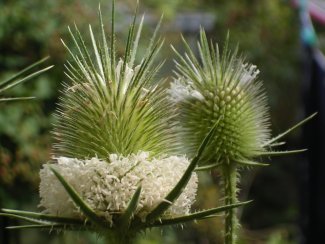Native to Asia-Temperate: Caucasus: Armenia; Azerbaijan; Georgia; Russian Federation-Ciscaucasia - Ciscaucasia
Middle Asia: Kyrgyzstan; Tajikistan; Turkmenistan
Western Asia: Afghanistan; Iran; Iraq; Israel; Lebanon; Syria; Turkey
Europe: East Europe: Moldova; Ukraine
Middle Europe: Austria; Czechoslovakia; Germany; Hungary; Poland; Switzerland
Southeastern Europe: Albania; Bulgaria; Former Yugoslavia; Greece; Italy; Romania
Southwestern Europe: France
Dipsacus laciniatus is a species of flowering plant in the honeysuckle family known by the common name cutleaf teasel. It is present in North America as an introduced species and invasive weed. This plant is a perennial herb that may grow up to two to three meters in height. The erect, branching stem is hollow and prickly. The leaves are oppositely arranged, each leaf pair joined around the stem and clasping it, their bases forming a cup which often collects water. The species is monocarpic, living for multiple years but only flowering once before dying. The inflorescence is an egg-shaped head subtended by long bracts. The head may contain up to 1500 flowers. Blooming lasts one day. The middle of the head blooms first and then the upper and lower parts. The fruit is an achene just under a centimeter long. Is noted as a biennial forb/herb by USDA PLANTS.
Cutleaf teasel (Dipsacus laciniatus L.) is an invasive plant introduced into the New England states from France in the 18th century for separating wool strands in the textile industry.
